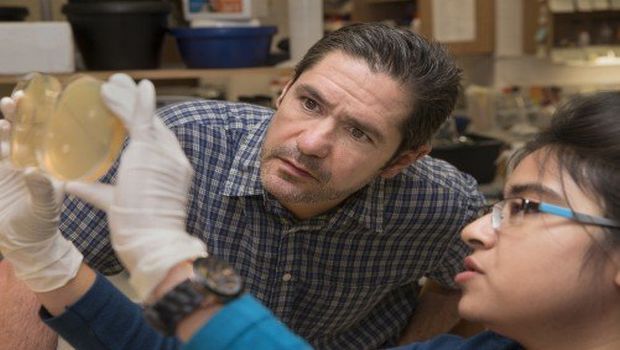Scientist Identifies Natural Weapons Against Antibiotic Resistance
Dr. Hans Wildschutte has his eye on finding answers to the serious global issues of antibiotic resistance and novel drug discovery. The research in Wildschutte’s lab focuses on finding environmental bacteria that can kill one or multiple pathogens.


Dr. Hans Wildschutte, BGSU assistant professor. Courtesy of Brad Phalin, BGSU
Dr. Hans Wildschutte has his eye on finding answers to the serious global issues of antibiotic resistance and novel drug discovery. The research in Wildschutte’s lab focuses on finding environmental bacteria that can kill one or multiple pathogens.
A paper, “Environmental Pseudomonads Inhibit Cystic Fibrosis Patient-Derived Pseudomonas aeruginosa,” recently accepted by the journal Applied and Environmental Microbiology, is another step toward that goal. The Pseudomonads findings are an important discovery in the battle against antibiotic resistance.
Wildschutte also ties his lab’s research into his undergraduate Introduction to Microbiology class that follows the Small World Initiative (SWI), which addresses antibiotic discovery through an innovative citizen science curriculum.
The bacterium Pseudomonas aeruginosa infects the lungs of cystic fibrosis patients and causes a serious life-threatening illness. Most strains of P. aeruginosa are multidrug resistant, which complicates cystic fibrosis treatment, leading to failure of the treatment in patients or adverse effects from advanced antibiotic drug regimens.
The study, in collaboration with Dr. John. J. LiPuma, a physician treating cystic fibrosis patients at the University of Michigan, looked at 30 different pathogens isolated from the lungs of patients with cystic fibrosis and tested 330 environmental isolates against them. The cystic fibrosis-derived pathogens are useful in research because they are opportunistic and only infect people who have cystic fibrosis or a compromised immune system.
“When we first started this, we knew some of the cystic fibrosis pathogens were multidrug resistant,” Wildschutte said. “Simply by co-growing them together, we can see what environmental isolates are able to inhibit the growth of these pathogens.”
For example, one of the pathogens was impacted by 30 different strains and another pathogen was inhibited by more than 35 isolates, Wildschutte said. “It’s pretty remarkable.”
The next step in the research involves creating mutations within the environmental strains so they can no longer kill the pathogens. Of the thousands of mutants generated, the researchers identified between five and 10 that lost the ability to kill the pathogen.
“We then have to find out where this mutation is in the entire genome,” Wildschutte said. “We optimized genetic techniques that allow us to identify what mutated genes are involved in antibiotic production. The results allow us to pinpoint gene clusters involved in antibiotic production.”
The research has been very productive to date.
“It’s the first study that has been done in such a broad context,” Wildschutte said. “We are looking at multiple environmental isolates and their range in activity against multiple different pathogens. If we pick strains from distinct environments and that are inhibiting different pathogens, then that increases our chances of identifying something new. That’s the approach that we’ve developed at BGSU, and so far, we haven’t found the same thing twice.
“The problem with antibiotic resistance is serious,” he said. “We are approaching the pre-antibiotic era prior to the 1940s when we didn’t have antibiotics. Essentially people will start dying from simple infections because they will be infected by bacteria that are resistant to all antibiotics.”
The success to date allows him to extend the research to demonstrate how the different strains are producing unique compounds.
“It’s a pipeline now that we’ve generated,” Wildschutte said. “We have a unique collection of 330 strains that we are just going through now.” It has taken three years to get the process up and running, but that now has significant success because of the number of environmental strains that have activity and the broad utility of the research workflow application.
The paper is co-authored by BGSU colleagues Drs. Robert McKay, Ryan Professor of Biology, and Daniel Wiegmann; Drs. LiPuma and David Sherman, both University of Michigan; BGSU graduate students Payel Chatterjee and Elizabeth Davis and Michigan graduate student Fengan Yu, and BGSU undergraduate student Sarah James, who graduated last year.
Source: Bowling Green State University
IDEA in Action: A Strategic Approach to Contamination Control
January 14th 2025Adopting IDEA—identify, define, explain, apply—streamlines contamination control. Infection control professionals can mitigate risks through prevention, intervention, and training, ensuring safer health care environments and reducing frequent contamination challenges.
Balancing Freedom and Safety: When Public Health Mandates Are Necessary
January 9th 2025Public health mandates, such as lockdowns, masking, and vaccination, balance liberty and safety, ensuring critical protections during pandemics like COVID-19 while fostering long-term survival through science.
Long-Term Chronicles: Infection Surveillance Guidance in Long-Term Care Facilities
January 8th 2025Antibiotic stewardship in long-term care facilities relies on McGeer and Loeb criteria to guide infection surveillance and appropriate prescribing, ensuring better outcomes for residents and reducing resistance.
Considering Avian Flu: World Health Organization Expert Warns Against Raw Milk
January 6th 2025Drinking raw milk poses risks of disease transmission, especially with H5N1 outbreaks. Expert Richard J. Webby, PhD, advises against raw cow or goat milk consumption due to its unpredictable and significant risks.